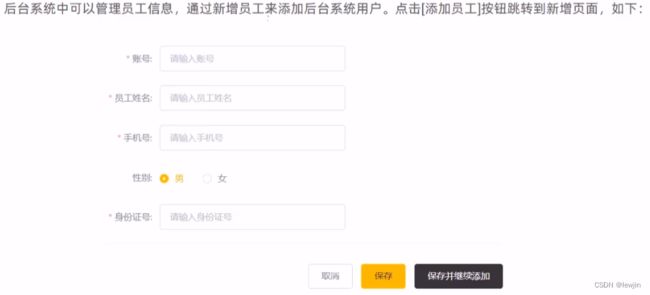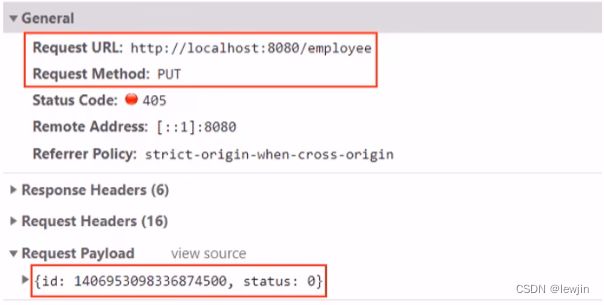Java项目实战笔记(瑞吉外卖)-3
新增员工功能
需求分析

数据模型


代码开发
在开发代码之前,需要梳理一下整个程序的执行过程:
- 页面发送ajax请求,将新増员工页面中输入的数据以json的形式提交到服务端
- 服务端 Controller接收页面提交的数据井调用 Service将数据进行保存
- Servicei调用 Mapper操作数据库,保存数据
/**
* 新增员工
* @param request
* @param employee
* @return
*/
@PostMapping
public R<String> save(HttpServletRequest request, @RequestBody Employee employee){
log.info("新增员工, 员工信息:{}",employee.toString());
//设置初始密码123456,需要进行md5加密处理
employee.setPassword(DigestUtils.md5DigestAsHex("123456".getBytes()));
employee.setCreateTime(LocalDateTime.now());
employee.setUpdateTime(LocalDateTime.now());
//获得当前登录用户的id
Long empId = (Long) request.getSession().getAttribute("employee");
employee.setCreateUser(empId);
employee.setUpdateUser(empId);
employeeService.save(employee);
return R.success("新增员工成功");
}
前面的程序还存在一个问题,就是当我们在新增员工时输入的账号已经存在,由于 employee表中对该字段加入了唯一约束,此时程序会抛出异常:

全局异常处理器
package com.itheima.reggie.common;
import lombok.extern.slf4j.Slf4j;
import org.springframework.stereotype.Controller;
import org.springframework.web.bind.annotation.ControllerAdvice;
import org.springframework.web.bind.annotation.ExceptionHandler;
import org.springframework.web.bind.annotation.ResponseBody;
import org.springframework.web.bind.annotation.RestController;
import java.sql.SQLIntegrityConstraintViolationException;
/**
* 全局异常处理
*/
@ControllerAdvice(annotations = {RestController.class, Controller.class})
@ResponseBody
@Slf4j
public class GlobalExceptionHandler {
/**
* 异常处理方法
* @return
*/
@ExceptionHandler(SQLIntegrityConstraintViolationException.class)
public R<String> exceptionHandler(SQLIntegrityConstraintViolationException ex){
log.error(ex.getMessage());
if(ex.getMessage().contains("Duplicate entry")){
String[] split = ex.getMessage().split(" ");
String msg = split[2] + "已存在";
return R.error(msg);
}
return R.error("未知错误");
}
}
员工信息分页查询功能
需求分析
系统中的员工很多的时候,如果在一个页面中全部展示出来会显得比较乱,不便于查看,所以一般的系统中都会以分页的方式来展示列表数据。

代码开发
在开发代码之前,需要梳理一下整个程序的执行过程:
- 页面发送ajax请求,将分页查询参数(page、 pagesize、name)提交到服务端
- 服务端 Controller接收页面提交的数据并调用Service查询数据
- Service调用 Mapper操作数据库,查询分页数据
- Controller将查询到的分页数据响应给页面
- 页面接收到分页数据井通过ElementUI的Table组件展示到页面上

/**
* 员工信息分页查询
* @param page
* @param pageSize
* @param name
* @return
*/
@GetMapping("/page")
public R<Page> page(int page, int pageSize, String name){
log.info("page = {},pageSize = {},name = {}" ,page,pageSize,name);
//构造分页构造器
Page pageInfo = new Page(page,pageSize);
//构造条件构造器
LambdaQueryWrapper<Employee> queryWrapper = new LambdaQueryWrapper();
//添加过滤条件
queryWrapper.like(StringUtils.isNotEmpty(name),Employee::getName,name);
//添加排序条件
queryWrapper.orderByDesc(Employee::getUpdateTime);
//执行查询
employeeService.page(pageInfo,queryWrapper);
return R.success(pageInfo);
}
启用/禁用员工账号功能
需求分析
- 在员工管理列表页面,可以对某个员工账号进行启用或者禁用操作。账号禁用的员工不能登录系统,启用后的员工可以正常登录。需要注意,只有管理员( admin用户)可以对其他普通用户进行启用、禁用操作,所以普通用户登录系统后启用禁用按钮不显示。
- 管理员 admin登录系统可以对所有员工账号进行启用、禁用操作。如果某个员工账号状态为正常,则按钮显示为“禁用”如果员工账号状态为已禁用,则按钮显示为“启用”
在开发代码之前,需要梳理一下整个程序的执行过程:
- 页面发送ajax请求,将参数(id、 status)提交到服务端
- 服务端 Controller接收页面提交的数据并调用Service更新数据
- Service调用 Mapper操作数据库

启用/禁用的员工账号,实际上就是一个更新操作,也就是对status状态字段进行修改操作,因此在controller中创建update方法,该是一个通用的修改员工信息的方法,因为status也是employee中的一个属性而已;这里使用了动态SQL的功能,根据具体的数据修改对应的字段信息;
/**
* 根据id修改员工信息
* @param employee
* @return
*/
@PutMapping
public R<String> update(HttpServletRequest request,@RequestBody Employee employee){
log.info(employee.toString());
Long empId = (Long)request.getSession().getAttribute("employee");
employee.setUpdateTime(LocalDateTime.now());
employee.setUpdateUser(empId);
employeeService.updateById(employee);
return R.success("员工信息修改成功");
}
功能测试:测试时出现了问题,当修改员工的状态,提示信息显示修改成功,但是数据库中的员工的状态码压根就没有变化,这是为什么?

观察id后,发现后台的SQL语句使用的id和数据库中的id是不一样的!
原因:mybatis-plus对id使用了雪花算法,所以存入数据库中的id是19为长度,但是前端的js只能保证数据的前16位的数据的精度,对id后面三位数据进行了四舍五入,所以就出现了精度丢失,导致提交的id和数据库中的id不一致。
解决:可以在服务端给页面响应json数据时进行处理,将Long型的数据 统一转为String类型的字符串
![]()
具体的实现步骤:
- 提供对象转换器JacksonObjectMapper,基于Jackson进行Java对象到json数据的转换
- 在WebMvcConfig配置类中扩展Spring MVC的消息转换器,在此消息转换器中使用提供的对象转换器进行Java对象到json数据的转换
自定义消息转换类
package com.itheima.reggie.common;
import com.fasterxml.jackson.databind.DeserializationFeature;
import com.fasterxml.jackson.databind.ObjectMapper;
import com.fasterxml.jackson.databind.module.SimpleModule;
import com.fasterxml.jackson.databind.ser.std.ToStringSerializer;
import com.fasterxml.jackson.datatype.jsr310.deser.LocalDateDeserializer;
import com.fasterxml.jackson.datatype.jsr310.deser.LocalDateTimeDeserializer;
import com.fasterxml.jackson.datatype.jsr310.deser.LocalTimeDeserializer;
import com.fasterxml.jackson.datatype.jsr310.ser.LocalDateSerializer;
import com.fasterxml.jackson.datatype.jsr310.ser.LocalDateTimeSerializer;
import com.fasterxml.jackson.datatype.jsr310.ser.LocalTimeSerializer;
import java.math.BigInteger;
import java.time.LocalDate;
import java.time.LocalDateTime;
import java.time.LocalTime;
import java.time.format.DateTimeFormatter;
import static com.fasterxml.jackson.databind.DeserializationFeature.FAIL_ON_UNKNOWN_PROPERTIES;
/**
* 对象映射器:基于jackson将Java对象转为json,或者将json转为Java对象
* 将JSON解析为Java对象的过程称为 [从JSON反序列化Java对象]
* 从Java对象生成JSON的过程称为 [序列化Java对象到JSON]
*/
public class JacksonObjectMapper extends ObjectMapper {
public static final String DEFAULT_DATE_FORMAT = "yyyy-MM-dd";
public static final String DEFAULT_DATE_TIME_FORMAT = "yyyy-MM-dd HH:mm:ss";
public static final String DEFAULT_TIME_FORMAT = "HH:mm:ss";
public JacksonObjectMapper() {
super();
//收到未知属性时不报异常
this.configure(FAIL_ON_UNKNOWN_PROPERTIES, false);
//反序列化时,属性不存在的兼容处理
this.getDeserializationConfig().withoutFeatures(DeserializationFeature.FAIL_ON_UNKNOWN_PROPERTIES);
SimpleModule simpleModule = new SimpleModule()
.addDeserializer(LocalDateTime.class, new LocalDateTimeDeserializer(DateTimeFormatter.ofPattern(DEFAULT_DATE_TIME_FORMAT)))
.addDeserializer(LocalDate.class, new LocalDateDeserializer(DateTimeFormatter.ofPattern(DEFAULT_DATE_FORMAT)))
.addDeserializer(LocalTime.class, new LocalTimeDeserializer(DateTimeFormatter.ofPattern(DEFAULT_TIME_FORMAT)))
.addSerializer(BigInteger.class, ToStringSerializer.instance)
.addSerializer(Long.class, ToStringSerializer.instance)
.addSerializer(LocalDateTime.class, new LocalDateTimeSerializer(DateTimeFormatter.ofPattern(DEFAULT_DATE_TIME_FORMAT)))
.addSerializer(LocalDate.class, new LocalDateSerializer(DateTimeFormatter.ofPattern(DEFAULT_DATE_FORMAT)))
.addSerializer(LocalTime.class, new LocalTimeSerializer(DateTimeFormatter.ofPattern(DEFAULT_TIME_FORMAT)));
//注册功能模块 例如,可以添加自定义序列化器和反序列化器
this.registerModule(simpleModule);
}
}
扩展mvc框架的消息转换器类
/**
* 扩展mvc框架的消息转换器
* @param converters
*/
@Override
protected void extendMessageConverters(List<HttpMessageConverter<?>> converters) {
log.info("扩展消息转换器");
//创建消息转换器对象
MappingJackson2HttpMessageConverter messageConverter = new MappingJackson2HttpMessageConverter();
//设置对象转换器,底层使用Jackson将Java对象转为json
messageConverter.setObjectMapper(new JacksonObjectMapper());
//将上面的消息转换器对象追加到mvc框架的转换器集合中
//转换器是有优先级顺序的,这里我们把自己定义的消息转换器设置为第一优先级,所以会优先使用我们的转换器来进行相关数据进行转换,如果我们的转换器没有匹配到相应的数据来转换,那么就会去寻找第二个优先级的转换器,以此类推
converters.add(0, messageConverter);
}
使用f12查看服务器响应到浏览器的用户id是不是变成了字符串,和数据库中是否相对应,发现对应,即消息转换器配置成功。然后再去测试 启用与禁用 员工账号这个功能,发现操作更新成功,并且数据库修改成功
![]()


编辑员工信息功能
需求分析
在员工管理列表页面点击编辑按钮,跳转到编辑页面,在编辑页面回显员工信息并进行修改,最后点击保存按钮完成编辑操作

代码开发
在开发代码之前需要梳理一下操作过程和对应的程序的执行流程:
- 点击编辑按钮时,页面跳转到add.html,并在url中携带参数[员工id]
- 在add.html页面获取url中的参数[员工id]
- 发送ajax请求,请求服务端,同时提交员工id参数
- 服务端接收请求,根据员工id查询员工信息,将员工信息以json形式响应给页面
- 页面接收服务端响应的json数据,通过VUE的数据绑定进行员工信息回显
- 点击保存按钮,发送ajax请求,将页面中的员工信息以json方式提交给服务端
- 服务端接收员工信息,并进行处理,完成后给页面响应
- 页面接收到服务端响应信息后进行相应处理
注意:add.html页面为公共页面,新增员工和编辑员工都在此页面操作
根据前端传过来的员工id查询数据库进行数据回显给前端
/**
* 根据id查询员工信息
* @param id
* @return
*/
@GetMapping("/{id}")
public R<Employee> getById(@PathVariable Long id){
log.info("根据id查询员工信息");
Employee employee = employeeService.getById(id);
if(employee != null){
return R.success(employee);
}
return R.error("没有查询到对应员工信息");
}
修改回显数据后,点击保存,会发送一个update的请求给后端,前面已经写过update的controller,所以只需要在前端跳转发请求就行。



